![]()
![]()
![]()
Use LEFT and RIGHT arrow keys to navigate between flashcards;
Use UP and DOWN arrow keys to flip the card;
H to show hint;
A reads text to speech;
50 Cards in this Set
- Front
- Back
|
Futurism
|
rejection of everything old, dull, “feminine”, and safe. Promoted the exhilarating “masculine” experiences of warfare and reckless speed (of modern technology and urban life)
|
|
|
Dada
|
Dada: Art movement of the European avant-garde. Concentrated its anti-war politics through a rejections of prevailing standards in art through anti-art works. Anti bourgeois and radically left leaning politically. Lays the groundwork for abstract, performance art, prelude to postmodernism and pop art.
|
|
|
Surrealism
|
Surrealism: attempt to resolve the contradictions between reality and dream. Shows unnerving, illogical scenes with photographic realism, strange creatures from every day objects. Had an element of surprise or unexpected juxtaposition.
|
|
|
Ashcan School
|
Ashcan School: artistic movement that is known for works portraying scenes of daily life in New York (usually in poorer neighborhoods)
|
|
|
Alfred Stieglitz
|
Alfred Stieglitz: American photographer and modern art promoter, worked to make photography an accepted art form. Introduced avant-garde European artists to a US market.
|
|
|
Harlem Renaissance
|
Harlem Renaissance: also known as the “New Negro Movement” was a movement of black art, centered in Harlem NYC
|
|
|
FSA Photography
|
FSA photography: A part of the New Deal in America, the Farm Security Administration was a post depression attempt to combat American rural poverty. Hired photographers to photograph the plight of the American rural farmer. It was supposed to provide information to “introduce America to Americans” . Featured 11 photographers, most notably Walker Evans, Dorothea Lange, and Gordon Parks. Created the image of the depression in the United States.
|
|
|
Action Painting
|
Action Painting: Style of painting in which paint is spontaneously dribbled, splashed, or smeared on the canvas. Represent the physical act of painting more than its actual imagery and composition. Closely associated with abstract expressionism
|
|
|
Colorfield Painting
|
Color Field Painting: An early form of abstract expressionism, shows large fields of flat solid color creating an unbroken surface. Less emphasis on form and stroke and more about overall consistency. Color is freed from objective context and becomes the subject itself.
|
|
|
British Pop Art
|
British Pop Art: The Independent Group, Interdisciplinary, “Hot” engaged in issues of politics and society
|
|
|
Andy Warhol
|
Andy Warhol: Used advertisements as art. Turns ready made things into fine art. Changes the context and intention of the artists. Ideas of self being expressed, what it means to create. Like a director, with a group of people that helped him in the factory.
|
|
|
Minimalism
|
Minimalism: geometric objects, fabricated, directly on the floor, no subject matter. Used new materials like fiber glass.
|
|
|
Earthworks
|
Earthworks: Art created using nature and landscape as a medium. Natural materials such as dirt, rocks, branches, or water. Usually left in the open, then erode away naturally, the changing being a part of the art itself. Many of the first works were in the deserts of Nevada, Arizona, NM, ect. Usually preserved through video or photograph.
|
|
|
Conceptual Art
|
Conceptual Art: The ideas or concepts involved are more important than traditional aesthetics or materials. Often called installations, can be set up following instructions instead of created. Questions the nature of art and does not involved traditional painting or sculpture.
|
|
|
Feminist Art
|
Feminist Art: The creation of art that represents women’s lives and experiences. Sought to bring more visibility to female artists (current and historic). Had an international presence and was one of the most influencial international art movements.
|
|
|
Postmodernism
|
Postmodernism: A group of art movements that sought to contradict modernism. Include intermedia, conceptual art, installation art, and multimedia. Include the use of words as a central element, bricollage, collage, simplification, performance art, recycling of past themes in a modern context. Breaks the barrier between fine art, low art, and pop culture.
|
|

|
Boccioni, Unique Forms of Continuity in Space, Italy, Futurism
Aimless male nude in a powerful stride- about the contours of the muscular body flutter into the surrounding space, expressing the figures great velocity and vitality as it rushes forward (symbolic of a brave, futureist world) mimics machinery of WWI and new technological advancements. Attacks feminine art and shows experiences. (created with a manifesto) |
|

|
Malevich, Black Square, Russia, Supremism
Malevich created 4 Black Squares, which were the basis for Suprematism, an artistic movement that focused on the use of basic geometric forms in a limited color range. Based on the supremacy of pure artistic feeling rather than then depiction of objects. Anti-materialist, anti-utilitarian philosophy. |
|
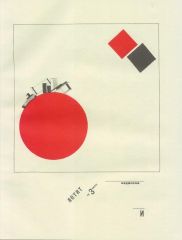
|
Lissitzky, The Story of Two Squares, Russia, Constructivism
Orginially made as a childrens story. Visually tells the story of a red square trying to rebuild a new social city in definance of the mean black square. The red square is symbolic of life, revolution, and unlimited possibilities. The black square signifies old order, chaos, egotism, and death. Its about the Russian Revolution the triumph of Bolshevism. Constructivism, which derived from suprematism, sought to create art for social purposes. |
|

|
Gropius, Bauhaus in Dessau, Deassau Germany, Bauhaus
A school in Germany that combined crafts and fine arts. The building was designed in the approach to art that it taught. Literally means “House of Construction” Founded on the idea of creating “total” works of art, in which all art forms are brought together. It was designed with a return to futurism. One of the most influential buildings to Modernist architecture. |
|
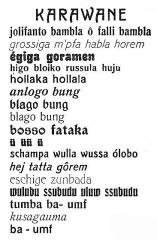
|
Ball, Karawane, Switzerland, Dada
Ball created the dada manifesto, which was a political statement about his views on how terrible society was and his dislike for philosophies that claim to possess the ultimate truth. Karawane is a poem made up of nonsensical words. The meaninglessness reflects the chief principle behind Dadaism. It critiques the meaninglessness of society, pokes fun at things that were considered serious, such as art and poetry. |
|

|
Hoch, Cut with the Dada Kitchen Knife, Germany, Berlin Dada
Combines newspaper images of the time, recreated to make a statement about life and art in the Dada Movement. Most of the Dadaist were reluctant to include a woman in their ranks. Put together hastily, Kitchen Knife shows anger and exhileration. It also has subtle feminist undertones, it includes images of some prominent women as well as a map highlighting the countries that have given women the right to vote. |
|
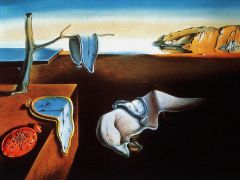
|
Dali, Persistence of a Memory, France, Surrealism
Introduced the famous Dali image of the melting pocket watch. Epitomizes Dali’s theory of softness vs hardness. An unconscious symbol of time and space, a surrealist meditation on the collapse of our notions of a fixed cosmic order. The figure in the middle is monsterous and a reflection of himself, making it an abstract self portrait. The watch in the bottom left is covered in ants as a symbol of death. The figure in the middle is fading, it represents when a dreamer cannot pinpoint a creatures exact form or composition. The creatures eye is closed meaning he too is asleep. The painting is an example of how surrealist use realist painting techniques to depict imagery found in dreams. |
|
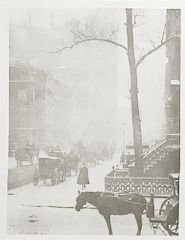
|
Alfred Stieglitz, The Street, United States, Modern Photography
Stieglitz used a handheld camera which allowed him to photograph the street scenes of new York. It is softly focused and has soft tonalities, it shows the precise moment when an unknowing protagonist stepped into the picture. Stieglitz is known for his work in promoting photography as an art form and refused to lower his prices or accept his work as any less then painted art. |
|
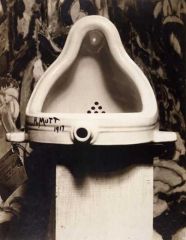
|
Duchamp, The Fountain, USA, New York Dada
The fountain was a photograph of a urinal signed R. Mutt. It was submitted to an exhibition by the society of independent artists but denied (even though they were supposed to accept everyone). The photograph was taken at Stieglitz studio. The work is regarded as a major landmark for 20th century Art. It caused much debate as to what is art, it wasn’t about him making it, it was about him choosing it, he created a new thought and life for the object. It showed a shift of art as physical craft to intellectual interpretation. |
|
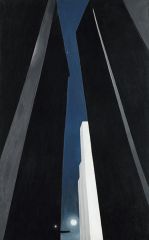
|
O'Keefe, City Night, USA, American Modernism
This painting of New York as it was rapidly growing and changing. It is of how New York is felt, not what it is. It takes the viewer a moment to realize what it is, if it is just shapes, is it fantasy, what is the angle you would have to stand at for this view. OKeefe was one the American Modernists in Stieglitz circle. It has a sense of majesty as well as intimidation.It makes the viewer feel claustrophobic. The skyscrapers do not show any light or source of life to them.Shows a contrast between the creation of man and nature- the buildings show man with shameless dominance, perfection and control. And the blue sky is nature when beauty was organic and not perfected. American Modernist frequently showed the power of humans to reshape, create, and improve their environment with the aid of scientific knowledge. |
|

|
Douglas, Aspects a Negro Life: From Slavery through Reconstruction, USA, Harlem Renaissance
Mural that expressed both classic African style and heritage with modernism and the jazz age. His large scale murals portrayed African American History and contemporary life in allegorical form. Has influences from music (scene in the drums and trumpet), the jungle is representative of Africa and their heritage. Music, heritage, geometric shapes were common in Harlem Renaissance paintings. |
|
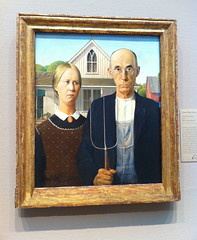
|
Wood, AMerican Gothic, USA, Regionalism
Regionalism showed American life as rural and simple, primarily in the Midwest. It contrasted the urban realist painters by not being based in social criticism. Some people saw American gothic as a celebration of American values, others saw it as a critique of the same thing. People outside the Midwest were confused by Woods who was a self proclaimed regionalist and didn’t know if he was making a statement about rural life or celebrating it. |
|

|
Lange, Migrant Mother Nipoma CA, USA, FSA Photography
Langes work for the FSA brought the plight of the poor and forgotten to public attention, they were distributed across the country and became iconic of the American Depression era. Migrant Mother features an image of a mother and her children. After publication the government rushed to the camp to aid starvation. |
|
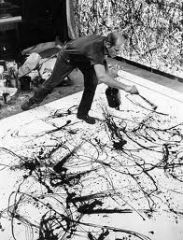
|
Namuth, Photo of Pollock Painting, USA, Documentary Photography
Documentary Photogrpahy is like photo journalism and is meant to chronicle a significant era or event. Namuth photographed Jackson Pollock in his studio to help viewers understand his works and techniques. His photographs showed that Pollocks works were planned and not just random splatters of paint and helped transform Pollock from a loner to a superstar in American contemporarty art and abstract expressionism. He was more interested in Pollock as a person then his art and sought to create and advertise a persona with his work. |
|
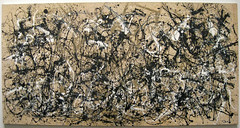
|
Pollock, Autumn Rhythm, USA, Action Painting
process more important than product. Freedom and reflection of art. Creating something from an empty canvas free of restrictions, possibility of exploring yourself. Art as a tool of freedom. Abstract Expressionism became defined as the new American art. Pollock became known as the face of American art. Aesthetics vs ethics |
|
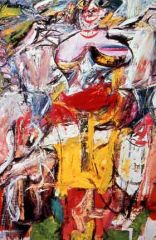
|
de Kooning, Woman on a Bicycle, United States, Action Painting
Koonings paintins were famous for being the only abstract expressionist paintings that were figurative, and not purely abstract. It featured aggressive brush strokes and strategically placed high key colors. The women were exaggerated sexually to show mens sexual fears and to be provocative. Sexually charged with a tight low cut outfit and high heels. |
|
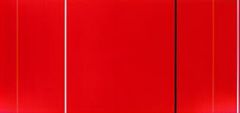
|
Newman, Vir Heroicus Sublimis, USA, Color Field Painting
uses symbolic form. An abstract shape can carry an idea and concept. His paintings recreate the history of art. Starts from the before painting existed, becomes a declaration of something. Searches for a universal truth. Birth out of chaos. Science and the beginning of life. Two sides with a zip down the middle, you can see the brush strokes. The zip is the artistic creation and divides and combines two fields. Not a geometric shape but a brush stroke. Story of creation, separating dark from light. |
|
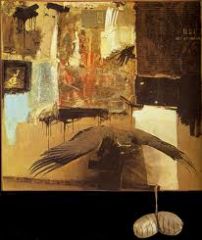
|
Rauschenberg, Canyon, USA, Assemblage/neo-dada
Combines assemblage, painting and sculpture, and “real” objects. Rauschenberg, Canyon, 1959: art is choices, you don’t have to make it you just choose it. References cubism. Exploration of the collage and materials. Transition from abstract expression to pop art, taking objects from low life and making it into art. |
|
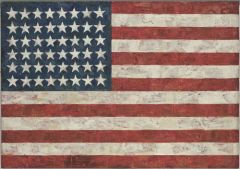
|
Johns, Flag, USA, Assemblage/neo-dada
also worked with found objects. Create a meaningless thing and let the viewer find meaning in it. Painting is not a representation of something. Flag, 1954-55: Means a lot but doesn’t have to have meaning in the painting. The object carries the meaning, not the painting |
|

|
Hamilton, Just what is it that makes today's homes so different, so appealing?, G Britain, Pop Art
First work of iconic popart. It uses popular images taken form various magazines to comment on the rapid and fundamental change of everyday existence. It is about a world that has been overran mall shoppers, and throwaway buyers. The world is overtaken with capitalism, the viewer is reminded of how quickly the population forgets the irresponsibility of over spending. It plays to the irony of pop art being marketable and sellable while hving a tone of doubtfulness to the marketable world. It is a parody of art. It represents the world of art at the time and its context in social criticism. |
|
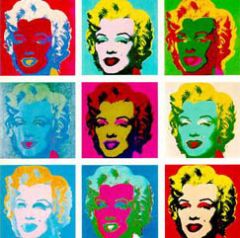
|
Warhol, Marilyn Diptych, USA, PopArt
Takes empty boxes and has assistant make silk screens, factory like creation. Head artist and assistants. What is art and authenticity? Can you use printing techniques or multiple people in art. Questions art making and the artists process. He did Marilyn in many colors and representations, image taken from a glamour shot of her. Advertisement world glamorization- makes you think about what magazines did to Marilyn, makes viewer think of things outside of the gallery and in the real world. IF YOU SEE SOMETHING OVER AND OVER (IN THE COMMERCIAL WORLD) DOES IT LOSE ITS MEANING OR CAUSE A REACTION (not sure if Warhol was criticizing or glorifying) |
|
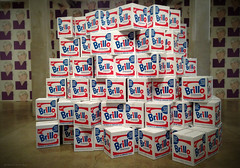
|
Warhol, Brillo Boxes, USA, Pop Art
A replication of the American commercial culture. Comments on the commercial framework behind art and art galleries by featuring mundane products from the supermarket world in a high art society. Brillo Boxes captures the power of advertisement as it markets steel wool to Americas housewives. Advertisment can mutate substance and gender at will, marketing a mascualine product to the feminine or making something into something else. Furhtermore the brillo boxes are filled with nothing, possibly making a statement about how worthless these items that America has become obsessed with really are. |
|
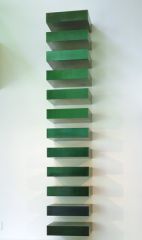
|
Judd, Untitled (Green Stack) USA Minimalism
Judd created autonomy and clarity in his constructions and the space created by it. He used simple, repeated forms to explore space and the use of space. His work was meant to suggest an industrial production line, featuring iron boxes painted in commercial green paint (meant for motorcycles). He had the boxes created in a factory to make them identical and perfect, giving them all the same exact size and spacing, making not one any more important than the others. He used a box shape because it was neutral and had no symbolic meaning. Minimalist set to expose the identity of an object by eliminating all unnecessary forms, features, or concepts. |
|
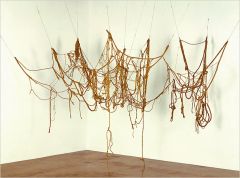
|
Hesse, Rope Piece, America, PostMinimalism
Hesse wanted to create art that was beyond the minimalist movements ideas of anti-expressionism and rigidity of form. Her pieces were meant to be organic nonart pieces that gave a new vision from an unseen reference point. They weren’t meant to be impersonal like the minimalist pieces but instead directly related to the body and its many quirks, as well as the emotional struggles of her life. Hesse escaped Nazis, her parents were divorce, her mother committed suicide, her marriage failed and her father died. Her art represented those struggles. She reinvents sculpture through aesthetic chaos. She died at 34 of brain cancer. |
|
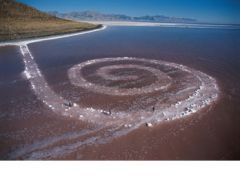
|
Smithson, Spiral Jetty, Great Salt Lake Utah, Earthworks
An example of Earthworks where the artist uses nature to create a work of art. It is built of mud, salt crystals, rocks, and water. It is only visible at certain points, depending on water level of the Great Salt Lake. It required obtaining land rights and commercial earthmoving equipment to build. People are unsure if they should preserve it because the artist meant for the art to mimic earthly attributes and be allowed to change and eventually destruct over time. |
|
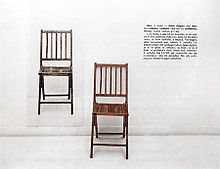
|
Kosuth, One and Three Chairs, USA, Conceptual Art
One and Three Chairs is an installation art piece with written instructions signed by the artists. To exhibit the piece the installer is to place a chair, then take a picture of the chair an place it to the left of the chair with a dicitionary definition of the word chair to the right. The piece unifies the idea of conceptual art with the realization of it. It demonstrates how an artwork can embody a constant idea despite changes to its elements. The piece highlights the relationship between language, picture, and referent. They symbolize one object in three and make the viewer what is real? Does the definition have meaning without the object itself. Or does the definition give the object meaning. Is the picture of a chair really a chair or just a photograph? |
|

|
Beuys, How to Explain Pictures to a Dead Hare, Germany, Performance Arts
The performance had Beuys explainging pictures to a dead hare while viewers viewed from outside the locked gallery. After three hours the viewers were let in and he stayed with his back to them one a chair holding the dead hare. It ironically celebrated the ritual of explaining art. It is about speech and conversation. The hare is symbolic of birth and incarnation. In the piece he wears a mask of honey and gold. The honey is representative of thoughts, and the human ability to think and produce ideas. Gold stood for strength and earthly connections. |
|
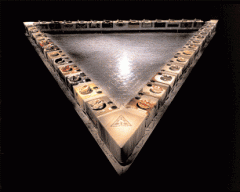
|
Chicago, The Dinner Party, USA, Feminist Art
The Dinner Party features place settings at a table for 34 mythical and historical famous women. Its intent was to end the ongoing cycle of omission in which women were written out of history. Each placesetting features a runner embroidered with the womans names and symbols of her accomplishments, many of the plates feature butterflys or flowers that symbolize the vulva. It celebrates art forms that had been doen by women such as textile art and china painting, which had been diminished as craft work instead of fine art. |
|
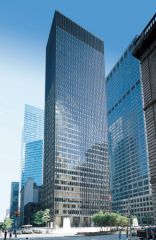
|
Mies Van Der Rohe and Johnson, Seagram Building NY, Modernist Architecture
A major influence on American architecture, the architects wanted to express the structure of the building externally, IT made the structural elements visibile and a part of the beauty. It was more honest than applied ornamentation. Due to building codes the building was created with bronze to show the outside and had a reinforced concenrete shell to support a non structural edifice. |
|
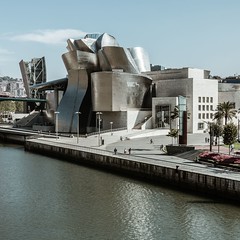
|
Gehry, Guggenheim Museum (Bilboa), Spain, Postmodern Architecture
Controversial because people were concerned that the building overshadowed the works inside, plus the concave exhibition spaces made it difficult to hang works on the wall. It was a spiral ramp that both tilted and featured nonvertical walls. Postmodern architecture was the rejection of modern architecture which showed flat, basic planes. It didn’t think you needed ornamentation but wanted more than flat surfaces. |
|

|
Polke, Raised Chair with Geese, Germany, Postmodernism
Postmodern art and this piece feature a mix of mediums and types of art. The raised chair can be a hunting chair which is illustrated by the drawing of geese. Or a lifeguard stand, which is shown by the fabric with beach scenes. Or it could be representative of a prision tower and symbolic of the concentration camps and walls of germany. |
|
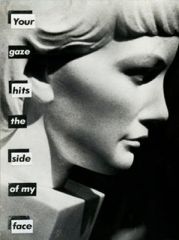
|
Kruger, Untitled (Your Gaze Hits The Side of My Face), USA, Postmodernism
This piece is a statement of women at the time. It is powerful. She feels the stares of men and the objectification, but her stone face shows that she is stronger then what she is made out to be. It is black and white but simplified by its strong shadow and reduction from 3d to 2d, a nod at the perceived simplicity of females. Her work combines text and image to create new content and questions our perception of gender. Shes uses words carefully as a powerful part of her piece, like many post modernist did. |
|
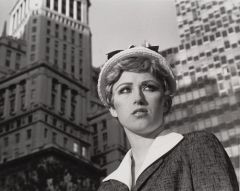
|
Sherman, Untitled Film Still #21, USA, Postmodernism
In the film stills, Sherman poses in different roles and settings, remnisicent of film noir. She doesn’t title her images to preserve their ambiguity. She tried to capture all the clichés of film. Although she does not consider herself a feminist, her work calls attention to the stereotyping of women in media. Although they are of herself they are not self portraits but instead a character. |
|
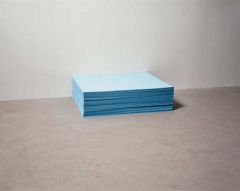
|
Gonzalez-Torres, Untitled (Loverboy), United States, Contemporary Art
|

